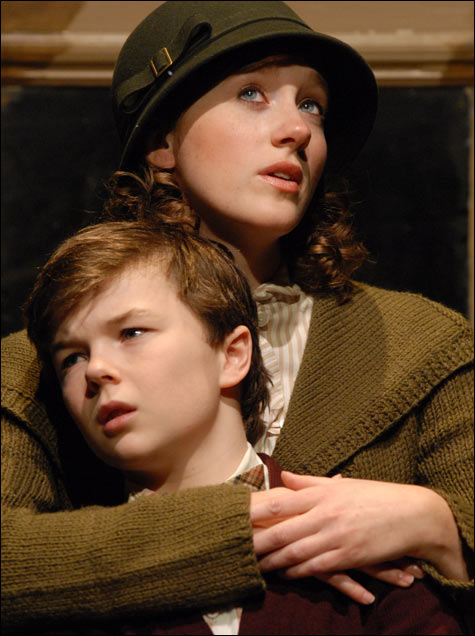
TROUBLED TIMES Evan Kinnane and Erin Sheehan in The Dark At the Top of the Stairs. |
European existentialist philosophers grandly designated fear and trembling — and subsets — as the default state of the human condition. But playwright William Inge employed a subtler intelligence when he domesticated that observation so well in his 1960 work, The Dark at the Top of the Stairs.As 2nd Story Theatre director Ed Shea makes clear in the current production (through April 5), outwardly normal home lives can be every bit as terrifying as Camus's ennui. The difference is, as Inge is proud to show, Oklahomans don't whine about it.
The first of the three acts is an endurance contest, ironically amplified by quick-march pacing that prevents the actors from projecting any emotional depth and us from empathizing. So initially their problems seem as commonplace as they are uninteresting. (Inge is cleverly setting us up, reminding us that people seem complex and fascinating only after we pay enough attention.)

Rubin Flood (Mark Gentsch) is a traveling salesman who usually returns home only briefly before setting out again. This is the early 1920s and, as automobiles are catching on, he is selling harnesses, about as hot an item as buggy whips. His wife Cora (Carol Schlink) is the stereotypical middle-American homebody. She's kind to a fault, and smotheringly protective of their shy 16-year-old daughter Reenie (Amy Thompson) and movie star-smitten 10-year-old Sonny (Evan Kinnane). Cora's sister, Lottie Lacey (Paula Faber), is a lighthearted chatterbox and seems pleasant enough. But her chatter includes contradicting or criticizing every observation made by her meek dentist husband, Morris (Frank Justin).
All of this proceeds conventionally until the end of Act II, when in walks Sammy Goldenbaum (Ryan Maxwell), and the play suddenly acquires a pounding heartbeat. Sammy is an out-of-town military academy student, a blind date for Reenie. He's as talkative as Lottie, but to kinder purpose. Little Sonny is in love with him immediately, not only because he comes from Hollywood, where his mother is a minor actress, but because he's so kind and understanding. Director Shea smartly freezes the others' actions and gives Sammy a spotlight for an introductory soliloquy explaining himself. As skillfully delivered with appropriate pep by Maxwell, it reveals profound sadness.
Sammy tends to not be accepted because he is Jewish, on top of having been tossed away by his mother. From this point on, others reveal where they're coming from, or they are unmasked. We learn that Rubin feels compelled to travel because he feels boxed in at home. He comes from pioneer stock and was a cowboy when he met a pretty girl fresh out of high school and settled down with Cora. He's always wanted to do the right thing and, in a gripping scene of angry apology to Cora, Gentsch powerfully delivers that understanding.
Similar revelations accumulate. Despite her frequently bawdy talk, Lottie's sex life with Morris has left a lot — well, everything — to be desired. (Justin wisely plays him not as a nebbish but with hard-pressed dignity.) Despite Cora constantly reprimanding her sister for unseemly talk, whenever she and Rubin patch things up after an argument they end up gleefully in bed.
A lesser playwright would sentimentally end this play as Inge concludes the second act, with Sonny looking up the stairs afraid of the unknown ahead, and his mother saying that all right, they'll go up together. But Inge structures things so that the last act has to prove the long-term benefit of such comfort. A tragedy occurs (two if you include an economic disaster), and the characters demonstrate how badly or well-prepared they are for the difficulties of life. By the upbeat closing moment, Inge and 2nd Story have convinced us that even if these people don't always make the best decisions, their hearts are in the right places.
With their imaginative leap from the usual bare-bones 2nd Story set, major kudos go to set designer Trevor Elliot and scenic artist Candis Dixon. Simulating a photocollage, people and faces, some emotionally intense, are "projected" on the entire set — floor, stairs and banisters, walls — as starkly as Sonny's movie star fantasies and the others' equally vivid thoughts. Where there is darkness, after all, we're bound to imagine things.